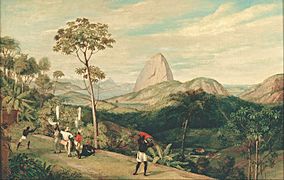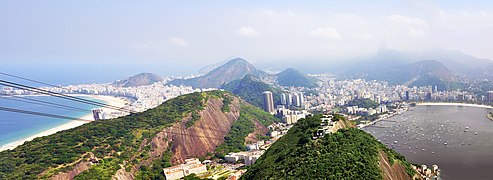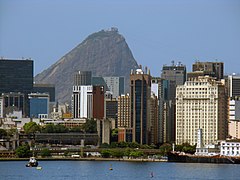geo.wikisort.org - Mountains
Sugarloaf Mountain (Portuguese: Pão de Açúcar, pronounced [ˈpɐ̃w̃ d͡ʒ(i) ɐˈsukaʁ]) is a peak situated in Rio de Janeiro, Brazil, at the mouth of Guanabara Bay on a peninsula that juts out into the Atlantic Ocean. Rising 396 m (1,299 ft) above the harbor, the peak is named for its resemblance to the traditional shape of concentrated refined loaf sugar. It is known worldwide for its cableway and panoramic views of the city and beyond.
This article may be expanded with text translated from the corresponding article in Portuguese. (July 2011) Click [show] for important translation instructions.
|
| Sugarloaf Mountain | |
|---|---|
 | |
| Highest point | |
| Elevation | 396 m (1,299 ft) |
| Coordinates | 22°56′55″S 43°09′26″W |
| Geography | |
 Sugarloaf Mountain Location in Rio de Janeiro | |
| Location | Rio de Janeiro |


The mountain is one of several monolithic granite and quartz mountains that rise straight from the water's edge around Rio de Janeiro. Geologically, it is considered part of a family of steep-sided rock outcroppings known as non-inselberg bornhardts.
The mountain is protected by the Sugarloaf Mountain and Urca Hill Natural Monument, created in 2006. This became part of a World Heritage Site declared by UNESCO in 2012.[1]
Origins of the name
The name Sugarloaf was coined in the 16th century by the Portuguese during the heyday of sugarcane trade in Brazil. According to historian Vieira Fazenda, blocks of sugar were placed in conical molds made of clay to be transported on ships. The form of the peak reminded them of the well-known resulting "sugarloaf" shape, and the nickname has since been extended to be a general descriptor for formations of this kind.[2]
Cable car
A glass-walled cable car (bondinho or, more formally, teleférico), capable of holding 65 people, runs along a 1,400 m (4,600 ft) route between the peaks of Sugarloaf and Morro da Urca every 20 minutes. The original cable car line was built in 1912 and rebuilt around 1972–73 and in 2008. The cable car goes from a ground station, at the base of Morro da Babilônia, to Morro da Urca and thence to Sugarloaf's summit.
Reaching the summit
To reach the summit, passengers take two cable cars. The first ascends to the shorter Morro da Urca, 220 m (722 ft) high. The second car ascends to Pão de Açúcar.[3] The Swiss-made bubble-shaped cars offer passengers 360° views of the surrounding city. The ascent takes three minutes from start to finish.
Timeline
- 1907 – Brazilian engineer Augusto Ferreira Ramos had the idea of linking the hills through a path in the air.
- 1910 – The same engineer founded the Society of Sugar Loaf and the same year the works were started. The project was commissioned in Germany and built by Brazilian workers. All parts were taken by climbing mountains or lifted by steel cables.
- 1912 – Opening of the cableway, the first in Brazil and the third of this kind worldwide;[4] the first cable cars were made of coated wood and were used for 61 years.
- 1973 – The current models of cars were put into operation. This increased the carrying capacity by almost ten times.
- 2009 – Inauguration of the next generation of cable cars that had already been purchased and are on display at the base of Red beach
- 2020 – Closed in March 2020 &[5] partially reopened in August 2020.[6]
Rock climbing
There are rock climbing routes on Sugarloaf that are mostly multipitch and are a mixture of sport and trad.[7] There are also two other mountains in the area with technical rock climbing, Morro da Babilônia[8] and Morro da Urca.[9] Together, they form one of the largest urban climbing areas in the world, with more than 270 routes, between 1 and 10 pitches long.
Appearances in media
- Flying Down to Rio (1933) Starring Fred Astaire and Ginger Rogers. The beachside Hotel Atlântico has views across the bay looking toward Sugarloaf Mountain.
- In the 1979 James Bond film Moonraker, the villainous henchman Jaws (played by Richard Kiel) attempts to kill 007 (Roger Moore) and the agent's ally, Dr. Holly Goodhead (Lois Chiles), on a cable car. However, Bond and Goodhead escape and Jaws collides with the building at the bottom of the cable car route, demolishing the building, but escaping unscathed.
- Herb Alpert recorded a song titled "Sugarloaf" for his 1982 album Fandango.
- The mountain and cable car are featured in The Simpsons episode "Blame it on Lisa", aired in 2002.
- Mechanic: Resurrection (2016), starring Jason Statham. At the beginning of the film Arthur Bishop (Statham) is attacked at a restaurant on Morro da Urca and escapes on the roof of a cable car.
Gallery
- View of Sugarloaf from the terrace of the Convento de Santo Antônio (Convent of St. Anthony), c. 1816. Painting by Nicolas-Antoine Taunay.
- View of Sugarloaf from the Silvestre road, c. 1823. Painting by Charles Landseer.
- Sugarloaf as seen from Glória neighborhood, c. 1846. Painting by Eduard Hildebrandt.
- Sugarloaf in 1914
- Higher aerial view, 1967
- View of the Sugarloaf from Christ the Redeemer on Corcovado.
- Cable cars from Sugarloaf Mountain.
- View of Sugarloaf Mountain from seaward side; Corcovado and Christ the Redeemer are seen in the background.
- View of Rio de Janeiro from the Sugarloaf.
- Sugarloaf as seen from the Praia Vermelha (Red beach).
- Botafogo Bay and Sugarloaf
- Botafogo Bay and beach with Sugarloaf in the background
- Aerial view
- Sugarloaf with Downtown Rio in the foreground
- View from the city of Niterói
References
- Monumento Natural dos Morros do Pão de Açúcar e da Urca (in Portuguese), SMAC: Secretaria Municipal de Meio Ambiente, retrieved 2017-01-15
- Allaby, Michael (2010). A Dictionary of Ecology (4th ed.). Oxford University Press. p. 53. ISBN 978-0-19-956766-9.
- Lonely Planet: Rio de Janeiro, page 76, Ricardo Gomes, John Maier Jr et al., 2006, Lonely Planet Publications, ISBN 1-74059-910-1
- "Sugarloaf Mountain". The Armchair Mountaineer. Retrieved 2021-02-13.
- "Rio's Christ statue closes and state of emergency decreed". ABC News (American). Retrieved 16 August 2020.
- "Brazil's Christ the Redeemer statue and Sugarloaf Mountain reopen Saturday". CNN. Retrieved 16 August 2020.
- "Rock Climbing in Pao de Acucar (Sugarloaf), Rio de Janeiro".
- "Rock Climbing in Morro da Babilonia, Rio de Janeiro".
- "Rock Climbing in Morro da Urca, Rio de Janeiro".
External links
 Media related to Sugarloaf Mountain at Wikimedia Commons
Media related to Sugarloaf Mountain at Wikimedia Commons- Official website
 — (in Portuguese, English, and Spanish)
— (in Portuguese, English, and Spanish)
На других языках
[de] Zuckerhut (Felsen)
Der Zuckerhut, portugiesisch Pão de Açúcar („Zuckerbrot“), ist ein 396 Meter[1] hoher, steilwandiger Felsen auf der Halbinsel Urca am westlichen Eingang zur Guanabara-Bucht in Rio de Janeiro, Brasilien. Er gehört zur gleichnamigen Hügelgruppe Pão de Açúcar, die außer ihm aus dem Morro da Urca und dem Morro da Babilônia besteht.- [en] Sugarloaf Mountain
[es] Pan de Azúcar (Brasil)
El Pan de Azúcar (en portugués, Pão de Açúcar) es un peñasco situado en Río de Janeiro, Brasil, en la boca de la bahía de Guanabara sobre una península que sobresale en el océano Atlántico.[fr] Mont du Pain de Sucre
Le mont du Pain de Sucre, ou simplement le Pain de Sucre (Pão de Açúcar en portugais), est un monolithe et un inselberg granitique situé dans la ville de Rio de Janeiro au Brésil. Il culmine à 396 mètres d'altitude et est accessible par un téléphérique.[it] Pan di Zucchero (Rio de Janeiro)
Il Pan di Zucchero (in portoghese Pão de Açúcar[1][2][3]) è un colle alto 396 m s.l.m. situato a Rio de Janeiro, in Brasile, su una penisola che si estende da un estremo della baia di Guanabara all'interno dell'oceano Atlantico.[ru] Пан-ди-Асукар (гора)
Пан-ди-Асу́кар[2] (порт. Pão de Açúcar — гора Сахарная Голова[3]) — гора в Рио-де-Жанейро, Бразилия. Высота — 396 м.Другой контент может иметь иную лицензию. Перед использованием материалов сайта WikiSort.org внимательно изучите правила лицензирования конкретных элементов наполнения сайта.
WikiSort.org - проект по пересортировке и дополнению контента Википедии















